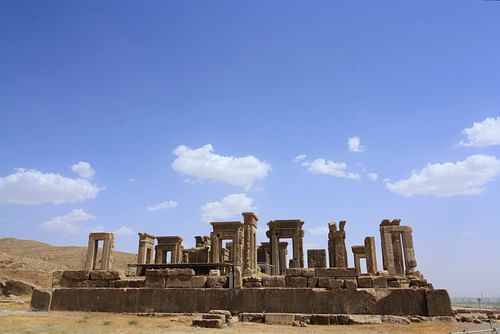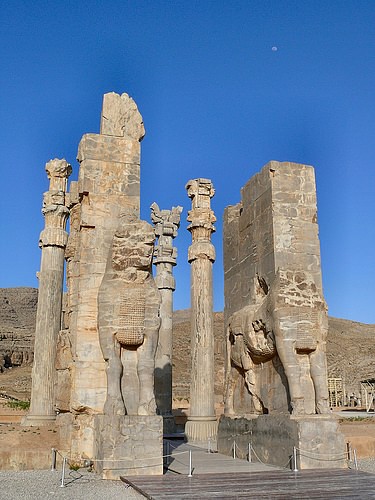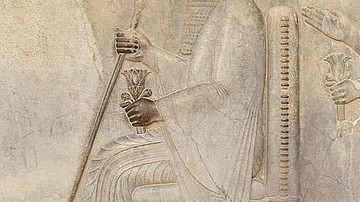
Persepolis was the capital of the Persian Achaemenid Empire from the reign of Darius I (the Great, r. 522-486 BCE) until its destruction in 330 BCE. Its name comes from the Greek Perses-polis (Persian City), but the Persians knew it as Parsa (City of the Persians).
Construction began between 518-515 BCE under Darius I who wanted a fresh start for Persian government administration and moved the capital from Pasargadae (the capital established by Cyrus the Great, r. c. 550-530 BCE). The city was located in a remote region in the mountains, however, making travel there difficult in the rainy season of the Persian winter, so the administration of the Achaemenid Empire was also overseen from Ecbatana, Babylon, and Susa. Persepolis was a spring/summer royal residence and seems to have been intended as a ceremonial center where representatives of subject states came to pay respects to the king.
The complex was comprised of nine structures:
- The Apadana (hypostyle receiving hall)
- Trachara (Palace of Darius I)
- Council Hall
- Treasury
- Throne Hall
- Palace of Xerxes I
- Harem of Xerxes I
- Gate of All Nations
- Tomb of the King
Of these nine, the first three were built by Darius I (who also began the treasury building) and the rest completed by his successors, notably his son Xerxes I (r. 486-465 BCE) and grandson Artaxerxes I (r. 465-424 BCE). There were also residential buildings, a marketplace, and structures which archaeologists have yet to positively identify, at least one of which is most likely the palace of Artaxerxes I.
Darius I's City
Darius I succeeded Cambyses II (r. 530-522 BCE), son of Cyrus the Great. Contrary to Darius I's own claims, the transition from Cambyses II's reign to his own was neither smooth nor peaceful. Darius I does admit that certain satrapies (provinces) rose in revolt when he came to the throne but minimizes the resistance to his reign while emphasizing loyal satrapies and his popularity and power.
The problem with the transition was that there was already a sitting king in place – Bardiya, brother of Cambyses II – who took control while Cambyses II was campaigning in Egypt. Cambyses II died on his way back from the campaign in 522 BCE, and Bardiya was then assassinated by Darius I. Darius I, however, claimed the man he killed was not Bardiya but a clever usurper named Gaumata who only looked like Bardiya. The actual Bardiya, Darius I claimed, had been killed by Cambyses II years before. Darius I, therefore, as a cousin of Cambyses II, was the legitimate heir to the throne. Very few of the satrapies believed this story, and Darius I had to spend the first few years of his reign putting down revolts.
Perhaps to distance his reign from this initial unpleasantness, as well as break ties with the past, Darius commissioned the new city to be built far from the old capital of Pasargadae and equally remote from established administrative centers such as Ecbatana, Babylon, and Susa. Scholar A.T. Olmstead suggests as much, writing:
Pasargadae spoke too eloquently of the supplanted dynasty, and Darius sought a new site for his capital. Twenty-five miles down the winding gorge of the Median River that watered the Pasargadae Plain, a rock-cut road led into another and broader plain. Through it flowed a yet larger river, the Araxes, to irrigate the fertile soil, until the stream disappeared in the great salt lake of southwestern Persia. (172)
On a cleared plain (known today as the Marv Dasht Plain), Darius raised an enormous platform-terrace 1,345,488 square feet (125,000 square meters) big and 66 feet (20 meters) tall on which he built his council hall, palace, and reception hall, the Apadana, featuring a 200 foot-long (60 meters) hypostyle hall with 72 columns 62 feet (19 meters) high supporting a roof of cedar and cedar beams from Lebanon. The columns were topped by sculptures of various animals symbolizing the king's authority and power, such as the bull and lion. At the four corners of the palace were four towers and the inner walls of the hall were brightly decorated. Outside, on the walls of the platform beneath the Apadana, bas-reliefs depicted the various people of the twenty-three subject nations of the Achaemenid Empire arriving with gifts to pay respects to the king. These reliefs are so precise in their detail that the nationalities represented are easily identified.

Limestone and mud-brick were the main building materials used at Persepolis. After natural rock had been leveled on the plain, and the depressions filled in, tunnels for sewage were dug underground through the rock and the platform began to rise. A large elevated cistern was carved at the eastern foot of the mountain behind the platform to catch rainwater for drinking and bathing. The complex was partly cut out of the Mountain Kuh-e Rahmet ("the Mountain of Mercy"). To create the level terrace, large depressions were filled with soil and heavy rocks which were then fastened together with metal clips; upon this ground the first palace at Persepolis slowly grew.
Around 515 BCE, construction of the broad stairways began, leading from the base of the terrace up to the palace doors. This grand, dual entrance to the palace, known as the Persepolitan stairway, was a masterpiece of symmetry and the steps were so wide that Persian royalty and those of noble birth could ascend or descend the stairs on horseback, thereby not having to touch the ground with their feet. The cut of the stairs, wide and broad, also served to slow the ascent of visitors to the king as one would have to step up and walk across one stair before reaching the next; this provided for a slow, stately ascent to the Apadana.
Xerxes' City
Though construction began under Darius I, the grandeur of the site overall was due mainly to the efforts of Xerxes I and Artaxerxes I with later embellishments added by Artaxerxes II (r. 404-358 BCE), Artaxerxes III (r. 358-338 BCE), and other Achaemenid kings. The names and images of both of Xerxes I and Artaxerxes I appear most often – as well as that of Darius I – inscribed on tablets, over doorways, and in hallways throughout the ruins of the city.
The great palace complex built by Xerxes I was entered through the Gate of All Nations, flanked by two monumental statues of lamassu (bull-men) who were thought to ward off evil. The gate opened onto a grand hall that was 82 feet (25 meters) long, with four large columns 60 feet high (18.5 meters) supporting a cedar roof. Here the representatives of the nations subject to the empire gave their tribute to the king. There were two doors, one to the south which opened to the Apadana yard and the other opening onto a winding road to the east. Pivoting devices found on the inner corners of all the doors indicate that they were two-leafed doors, probably made of wood, and covered with sheets of ornate metal.

Between his palace and the Council Room, Xerxes I constructed a residence for his harem consisting of 22 apartments and access to enclosed gardens. The harem could be reached either from his palace or the Council Room. The harem building was L-shaped, oriented north-south, with four grand doorways decorated with reliefs. The famous relief of Xerxes I followed by two attendants (one holding a parasol over the king's head and the other with a fly-whisk), frequently accompanying articles on Xerxes I, comes from the southern door jamb of the harem.
Behind the harem residence was the Treasury which housed the government archives, religious works and other writing, artworks, booty taken in conquest, and tribute brought to the city by subject nations. It also served as an armory and, toward the front, a reception hall for visiting diplomats which was decorated with reliefs depicting Darius I and Xerxes I. In front of both the treasury and harem was the Throne Hall (also known as Hall of 100 Columns) which was begun by Xerxes I and finished by Artaxerxes I.
Later Additions & Tombs
According to the historian Diodorus Siculus (1st century BCE), the city was ringed by three walls. When these walls were built or by whom is unknown since they were destroyed by Alexander the Great and nothing survives of them in the present day. The first wall, immediately around the terrace, was 23 feet (7 meters) high. The second, presumably with some interval between it and the first, was 46 feet high (14 meters), and the third rose to 89 feet (27 meters). These walls were topped by towers and always manned. A walkway, presumably, around the top enabled defense from any direction.
Behind the treasury and Xerxes' palace the royal stables and chariot house are thought to have been located. Structures on the south-east corner of the terrace have been tentatively identified as such and, close by, was the city's garrison which housed the regular standing army as well as the famous Ten Thousand Immortals, the king's personal bodyguard and shock force.
Along this same row was a building which housed the artisans' workshop and a number of small, mud-brick structures which were probably their residences. One of the many intriguing aspects of the ruins of Persepolis for archaeologists has been determining precisely what the function of the city was and who lived where. It seems, however, that the upper-class lived on the raised terrace and the common folk below in mud-brick homes which, according to Diodorus, were still quite respectable.
To the east side of the city is a royal tomb, though whose it is remains a matter of conjecture, and two miles (4 kilometers) to the northeast are the rock-cut cliff tombs of Darius I and his immediate successors. Those not interred in these tombs were buried at Persepolis, presumably in the area surrounding the eastern tomb.
Destruction of Persepolis
After his victory over Darius III (r. 336-330 BCE) at the Battle of Gaugamela in 331 BCE, Alexander the Great marched on the city of Susa, which surrendered without resistance. After leaving Susa for Persepolis, he received a letter from one Tiridates, satrap of Persepolis, telling him that Persians loyal to Darius III were en route to Persepolis to fortify it against him and, if he should arrive first, Tiridates would surrender the city to him but, if not, he would have to fight for it. Alexander ordered his men on a forced march, crossed the Araxes River, and were approaching the city when, according to Diodorus Siculus, they were met by a crowd of about 800 Greek artisans from Persepolis.

Almost all of them were elderly and had been taken prisoner and then mutilated by the Persians, they explained (some missing a hand, another a foot), so that they could still perform whatever skills required of them but were handicapped and so could not easily escape. Alexander gave them clothing and wages and is said to have been greatly moved, along with his senior staff, by the encounter. Although Diodorus does not say so, this meeting with the Greek artisans may have affected Alexander's attitude toward the city because, unlike at Susa, when he arrived there he gave his men free rein to sack the city – except for the palaces – and take whatever they wanted. Diodorus describes the scene:
[Persepolis] was the richest city under the sun and the private houses had been furnished with every sort of wealth over the years. The Macedonians raced into it, slaughtering all the men whom they met and plundering the residences; many of the houses belonged to the common people and were abundantly supplied with furniture and wearing apparel of every kind. Here much silver was carried off and no little gold, and many rich dresses gay with sea purple and with gold embroidery became the prize of the victors. (17.70.2-3)
After the city was taken, Alexander and his men celebrated with a party late into the night, drinking and feasting, until they were all – or nearly all – drunk. At some point, a woman of the group named Thais, suggested Alexander set the city on fire. Diodorus describes the destruction of Persepolis:
Alexander held games in honor of his victories. He performed costly sacrifices to the gods and entertained his friends bountifully. While they were feasting and the drinking was far advanced, as they began to be drunken, a madness took possession of the minds of the intoxicated guests. At this point one of the women present, Thais by name and Athenian by origin, said that for Alexander it would be the finest of all his feats in Asia if he joined them in a triumphal procession, set fire to the palaces, and permitted women's hands in a minute to extinguish the famed accomplishments of the Persians. This was said to men who were still young and giddy with wine, and so, as would be expected, someone shouted out to form up and to light torches, and urged all to take vengeance for the destruction of the Greek temples [burned by the Persians when they invaded Athens in 480 BCE]. Others took up the cry and said that this was a deed worthy of Alexander alone. When the king had caught fire at their words, all leaped up from their couches and passed the word along to form a victory procession in honor of the god Dionysus. Promptly many torches were gathered. Female musicians were present at the banquet, so the king led them all out to the sound of voices and flutes and pipes, Thais the courtesan leading the whole performance. She was the first, after the king, to hurl her blazing torch into the palace. As the others all did the same, immediately the entire palace area was consumed, so great was the conflagration. It was most remarkable that the impious act of Xerxes, king of the Persians, against the acropolis at Athens should have been repaid in kind after many years by one woman, a citizen of the land which had suffered it, and in sport. (17.72.1-6)
Diodorus is not the only ancient historian to make this claim, and it is generally accepted as accurate. The Roman historian Plutarch (l. c. 45 - c. 125 CE) relates a similar story, further claiming that Alexander carried away the treasures of Persepolis on the backs of 20,000 mules and 5,000 camels.
The fire, which consumed Persepolis so completely that only the columns, shards of walls, stairways, and doorways remained of the great palaces and halls, also destroyed the religious works of the Persians written on parchment as well as their works of art. The palace of Xerxes, who had planned and executed the invasion of Greece in 480 BCE, received especially brutal treatment in the destruction of the complex.
Conclusion
The city lay crushed under the weight of its own ruin (although, for a time, nominally still the capital of the now-defeated empire) and was lost to time. It became known to residents of the area only as 'the place of the forty columns' owing to the still-remaining columns standing among the wreckage. In time, the site came to be associated with supernatural entities, was considered haunted, and was then generally avoided.
In 1618 CE, the ruins were positively identified as Persepolis, but aside from amateur digs by treasure-hunters, no efforts were made to excavate the site. It was not until 1931 CE that professional excavations began and Persepolis again rose from the sands. These excavations supported the reports of the ancient historians regarding the burning of Persepolis as there was ample evidence among the ruins that the city had been destroyed by a great fire.
Although the fire had destroyed anything written on parchment, the clay tablets of cuneiform text were baked and then buried by rubble, preserving them. Among these are the Fortification Tablets (some 8,000 documents on the economics of the empire under Darius I), the Treasury Texts (administrative works from the reign of Artaxerxes I), and the so-called Travel Texts recording payments and rations given to travelers and their pack animals.
Since 1931 CE, aside from periods when conflict in the region prevented it, excavations have continued at the site. In the present day, it is an archaeological park located northwest of modern Shiraz, Iran, in the Fars province. It was declared a UNESCO World Heritage Site in 1979 CE and attracts visitors from around the world who come to experience the wonder that was once the great city of Persepolis.







